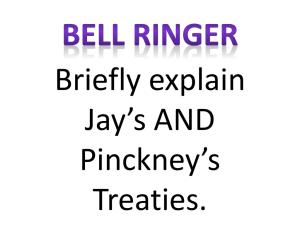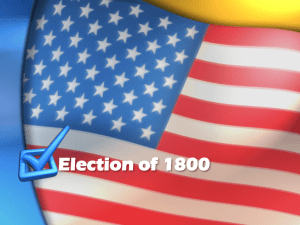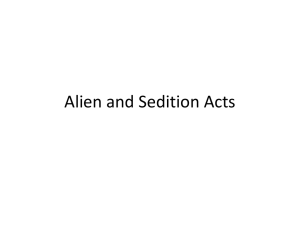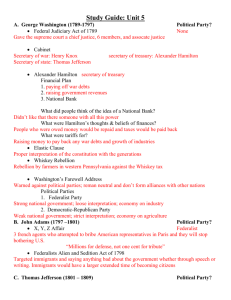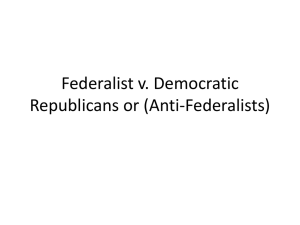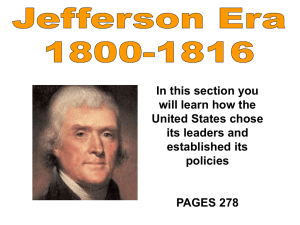Election of 1796:
advertisement
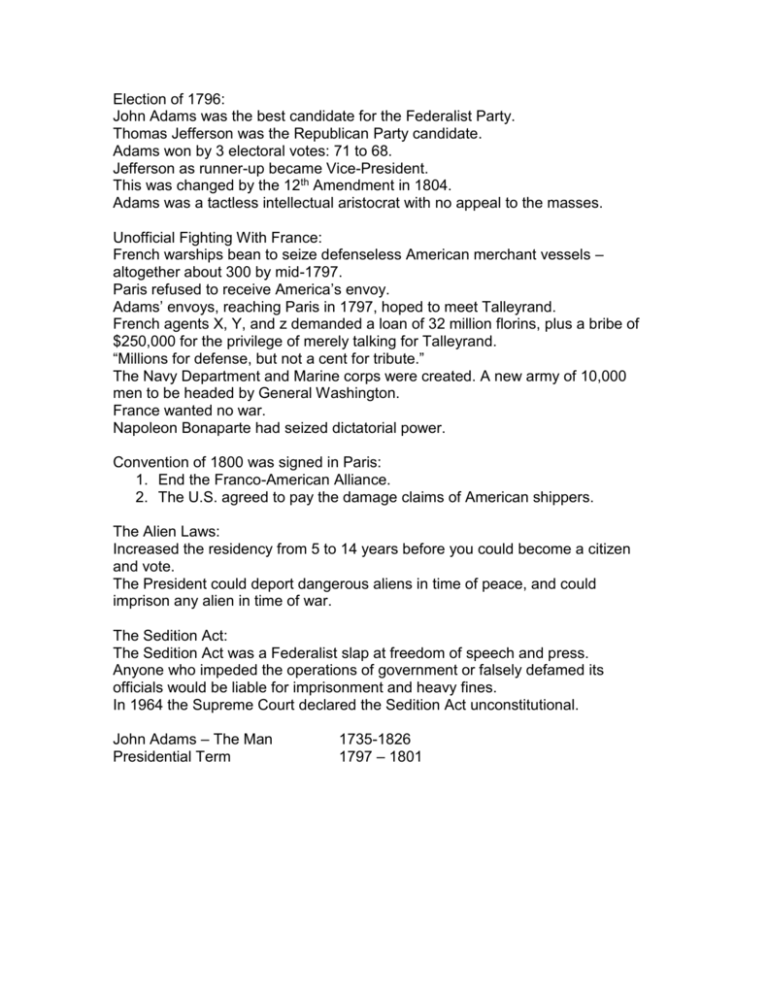
Election of 1796: John Adams was the best candidate for the Federalist Party. Thomas Jefferson was the Republican Party candidate. Adams won by 3 electoral votes: 71 to 68. Jefferson as runner-up became Vice-President. This was changed by the 12th Amendment in 1804. Adams was a tactless intellectual aristocrat with no appeal to the masses. Unofficial Fighting With France: French warships bean to seize defenseless American merchant vessels – altogether about 300 by mid-1797. Paris refused to receive America’s envoy. Adams’ envoys, reaching Paris in 1797, hoped to meet Talleyrand. French agents X, Y, and z demanded a loan of 32 million florins, plus a bribe of $250,000 for the privilege of merely talking for Talleyrand. “Millions for defense, but not a cent for tribute.” The Navy Department and Marine corps were created. A new army of 10,000 men to be headed by General Washington. France wanted no war. Napoleon Bonaparte had seized dictatorial power. Convention of 1800 was signed in Paris: 1. End the Franco-American Alliance. 2. The U.S. agreed to pay the damage claims of American shippers. The Alien Laws: Increased the residency from 5 to 14 years before you could become a citizen and vote. The President could deport dangerous aliens in time of peace, and could imprison any alien in time of war. The Sedition Act: The Sedition Act was a Federalist slap at freedom of speech and press. Anyone who impeded the operations of government or falsely defamed its officials would be liable for imprisonment and heavy fines. In 1964 the Supreme Court declared the Sedition Act unconstitutional. John Adams – The Man Presidential Term 1735-1826 1797 – 1801 The Election of 1800: John Adams was the Federalist candidate. Thomas Jefferson was the “Republican” candidate. Jefferson won by a majority of 73 electoral votes to Adam’s 65. Jefferson’s major strength was in the West and South. An unexpected deadlock = Jefferson the presidential candidate, and Aaron Burr, his vice-presidential running mate, received the same number of electoral votes for the presidency. The tie could only be broken by the House of Representatives – controlled by the Federalists. John Adams was the only Federalist President of the U.S. The Federalists were of the “elite.” Jefferson’s Administration: He started the precedent, unbroken for 112 years, of sending messages to Congress to be read by a clerk. Jefferson speedily pardoned the “martyrs” serving sentences under the Sedition Law. Naturalization Law of 1802 – reduced the requirement of 14 years of residency to the former requirement of 5 years. Chief Justice John Marshall: Marshall was appointed to the Supreme Court b Adams. Marshall was a cousin of Thomas Jefferson, but a Federalist, and disliked by he states-rights Jeffersonians. He served as a Federalist on the Supreme Court for 34 years. Marbury v. Madison – 1803: “Judicial Review” – the Supreme Court alone had the last word on the question of constitutionality. Jefferson and the Barbary States of North Africa: Jefferson distrusted large standing armies as a standing invitation to dictatorship. He reduced the military to a police force of 2,500 officers and men. Pirates of the North African states blackmailed and plundered merchant ships that entered the Mediterranean. In 1801 Tripoli informally declared war on the U.S. After 4 years of fighting, Jefferson extorted a treaty of peace from Tripoli in 1805. $60,000 – a sum representing ransom payments for captured Americans. About 200 tiny gunboats were now constructed, often mounting only one gun. This economizing backfired badly in the War of 1812. Jefferson Purchases Louisiana: In 1800 Napoleon Bonaparte induced the King of Spain to cede to France the immense Trans-Mississippi region of Louisiana, which included the New Orleans area. All U.S. frontier transportation was now at a standstill and the frontiersmen were in a fighting mood. Early in 1803 Jefferson sent James Monroe to Paris / Robert Livingston To buy New Orleans and as much land to the east as they could get for a maximum of $10 million. April 30, 1803 Louisiana was ceded to the U.S. for about $15 million. U.S. Response to the Louisiana Purchase: Jefferson was in a dilemma: Nowhere in the constitution was the President authorized to negotiate treaties for purchasing land. The Senate approved the treaty. With this transaction the U.S. doubled her size at 3¢ an acre. Why did Napoleon sell the Louisiana Purchase? 1. He needed quick money. 2. The Americans were threatening to make an alliance with England. 3. If the U.S. became stronger they would be a larger threat to England. 4. He felt the U.S. was weak; he could simply take it back by force. 5. He did not set definite boundaries, thus causing friction in later years. Exploring the Louisiana Purchase: Meriwether Lewis and William Clark ascended the Missouri River to the mouth of the Columbia River in Oregon. The mapped from 1804 to 1806, bolstering America’s claim to Oregon. Zebulon M. Pike, in 1805 – 1806, explored the Mississippi and in 1806 – 1807 ventured into Colorado and New Mexico. The Demise of Hamilton and Burr: Aaron Burr led a plot for secession of New England and New York. In 1804 Hamilton foiled this plot leading to a duel. Burr killed Hamilton – one of the brightest minds of the Federalist Party. Aaron Burr was arrested in 1806 for treason. He planned to separate the western part of the U.S. from the eastern part. The Election of 1804: Thomas Jefferson with 162 electoral votes. Charles C. Pinckney, Federalist candidate, with 14 votes. Vice-President was George Clinton. Shipping Problems with France and England: In 1806 – London closed the ports under French control to all foreign shipping, unless the vessels first stopped at the British port. Napoleon ordered the seizure of all merchant ships that entered British ports. Impressments – the forcible enlistment of sailors. 6,000 U.S. citizens were impressed by the English from 1808 to 1811 alone. America’s navy and merchant marine openly encouraged the enlistment of British deserters, and paid high wages. Jefferson’s Embargo: The warring nations in Europe were heavily dependent upon the U.S. for raw materials and foodstuffs. If America cut her exports, they would be forced to come and agree to respect her rights. New England’s harbors stood stagnate and farmers of the South and West suffered. New England seethed with talk of secession. Congress repealed the embargo on March 1, 1809, 3 days before Jefferson’s retirement. Thomas Jefferson – The Man Presidential Term 1743 – 1826 1801 – 1809

